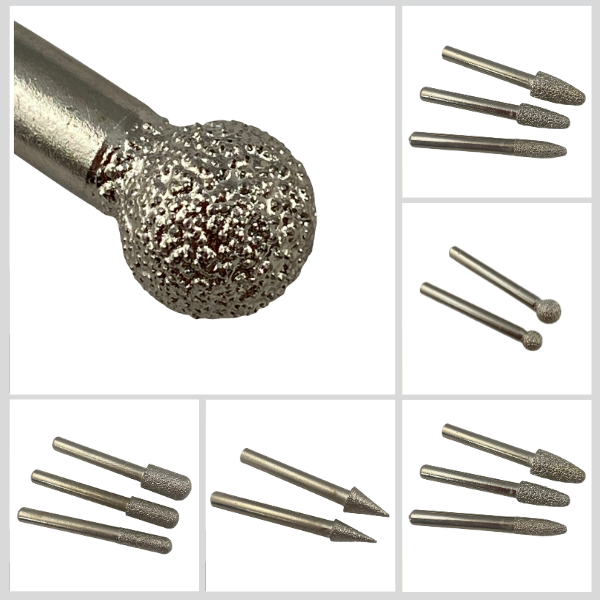Not all tools are created equal in the world of cutting, grinding, shaping, and polishing. The types of materials being worked on require different kinds of tools to achieve the desired results.
For instance, cutting through Glass Fiber-reinforced plastic, Composite Plastics, ceramics, carbide components, stone, tile, brick, quartz, granite, terrazzo, concrete, marble, and other hard materials needs a tool that can effectively handle such applications without causing damage or premature wear. Enter Vacuum Brazed Diamond Burs.
In this blog post, we will discuss what vacuum-brazed diamond burs are, their benefits, applications, and tips on how to use them effectively.
What Material Can Vacuum Brazed Diamond Burrs Be Used On?
- Glass Fiber-reinforced plastics
- Metal Alloys
- Composite Plastics
- Ceramics
- Porcelain
- Carbide components
- Stone
- Tile
- Brick
- Quartz
- Granite
- Terrazzo
- Concrete
- Marble
What are Vacuum Brazed Diamond Burs?
Vacuum-brazed diamond burs are special cutting tools made from high-quality diamonds and unique brazing technology.
This technology allows for the uniform distribution and high bonding of diamond particles on the burr's body, which results in exceptional cutting performance and long tool life.
Vacuum brazing is a process in which a high-quality diamond grit is fused to a metal substrate, such as steel or carbide body, using a high-temperature brazing process.
This fusion creates a powerful bond between the diamond particles and the burr body.
The result is a tool with superior cutting power and durability compared to traditional bonding methods, such as electroplating or sintering making them the ideal solution for extremely tough materials.
Benefits of Vacuum Brazed Diamond Burs
Vacuum-brazed diamond burs offer numerous advantages compared to their traditional counterparts. Some of these benefits include:
1. High Productivity
Because the vacuum brazed coating is uniform, this makes for a more aggressive cutting action, increasing productivity and ensuring faster material removal.
2. Extended Tool Life
The strong bond between the diamond grit and the tool body ensures that the diamonds remain in place for extended periods, directly translating to longer tool life. This also means fewer tool changes and lower operational costs.
3. Versatility
Vacuum-brazed diamond burs can be used in a wide range of applications, from simple grinding tasks to complex shaping jobs, making them perfect for various industries, such as automotive, construction, and aerospace.
Additionally, they are suitable for processing a broad range of materials, including hard and brittle materials like granite, marble, and glass.
4. Cool Cutting Performance
Vacuum-brazed diamond burs generate less heat during operation than electroplated or sintered diamond tools.
This ensures smooth cutting performance and reduces the likelihood of thermal damage to the work material.
Cool cutting performance is particularly beneficial when working with temperature-sensitive materials such as glass or composites.
5. Improved Safety
The strong bonding created by vacuum brazing technology reduces the risk of diamond particles becoming detached from the bur or shattering during operation, thus ensuring a safer work environment.
Applications of Vacuum Brazed Diamond BursVacuum-brazed diamond burs are versatile tools designed for use in various industries and on a wide variety of materials.
Some popular uses include:
Stone and Masonry: Vacuum-brazed diamond burrs are ideal for cutting, shaping, and engraving natural and engineered stones such as granite, marble, and quartz.
Ceramics: These burs can be used for cutting, grinding, and polishing ceramics, such as porcelain and tiles.
Glassworks: Vacuum-brazed diamond burs provide efficient and clean cuts for glass processing, including stained glass, fused glass, and various types of art glass.
Metal fabrication: They can be used to grind metal alloys, deburr edges, and remove welds.
Automotive: These tools can be employed in the automotive industry to remove casting marks, burrs, and other imperfections in engine components.
Dental and Medical: Vacuum-brazed diamond burs are often used for shaping and polishing dental materials like ceramics, metals, and bone in medical operations.
Tips on Using Vacuum Brazed Diamond Burrs Effectively
To get the most out of your vacuum-brazed diamond burs, consider the following tips:
Choose the correct grit size: The grit size directly affects the material removal rate and the tool's finish quality. A higher grit (small particles) provides a smoother surface finish, while a lower grit, such as 80# (large particles), increases cutting speed and material removal.
Usually, if you want a finer grit than 80#, we suggest choosing a sintered or coated (electroplated) diamond burr instead.
Use the correct operating speed: Always refer to the manufacturer's recommendations for the proper RPMs (Revolutions per Minute) when using vacuum-brazed diamond burs. We recommend not exceeding a speed of 12,000 RPM.
Apply light pressure: Excessive pressure may cause the diamonds to detach prematurely or push them into the tool's body. Light pressure during operation ensures that the diamonds maintain a proper cutting edge.
Maintain adequate cooling: Vacuum-brazed diamond burs are designed for cool cutting, but utilising appropriate cooling measures, such as water or cutting fluids, can help prolong the burr life.
Regularly inspect the tool: Inspect the diamond burr for wear, chips, or cracks before and after each use. Replace the burr if significant wear or damage is present.
Vacuum-brazed diamond burs are remarkable tools that offer numerous benefits over traditional diamond tools. Their excellent cutting performance, extended tool life, versatility, and cool cutting make them valuable for various industries and applications.
By following proper usage guidelines and choosing the right tool for your specific needs, you can maximize the efficiency and effectiveness of these incredible tools.



